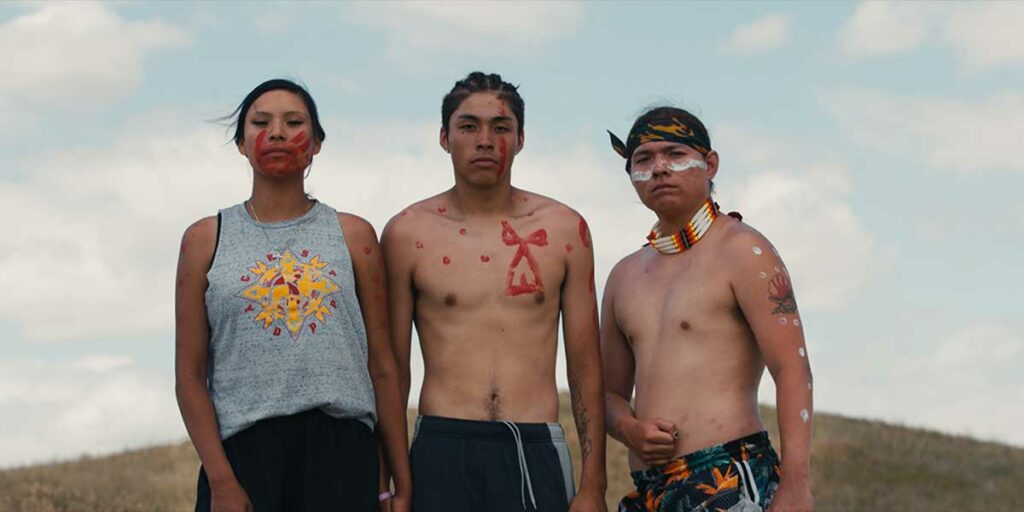Lakota Nation vs. United States is a narrative of a neglected part of America needing its story told, using poignant poetry and imagery to relay its message.
The history of Native Americans in relation to the central United States government is a tenuous one. The Lakota are one such story, with their battle with the United States continuing in many aspects to this day. Between bloody wars, demonization in the media, and the commodification of their land, the Lakota have been overexploited and displaced for over a century and a half. Whenever this story is told in school, it is often in the context of America’s Manifest Destiny and the growth and development of the nation in a positive light. History, however, is not so simple. Lakota Nation vs. United States is the story from the point of view of the native tribes who live there, and the fight to reclaim their territory which has continued all the way into the present day.
America’s Indian Wars persisted through the mid-1800s, but the story of this film is concerned with a particular conflict beginning in 1876 in the homeland of the Lakota people. Gold had been discovered in the Black Hills of South Dakota, leading to prospectors storming into the area. However, these hills were sacred land to the Lakota, Dakota, and Cheyenne people, who existed with their own leadership and governance, effectively sovereign nations themselves. Coming into this land for resources constituted a full scale invasion. In response, the tribes banded together and fought well against the attacking army. The United States responded by draining their waters and depleting their resources, exemplified by the killing of the buffalo. The result was a set of treaties leading to scattered tribal reservations and the Black Hills falling into federal custody.
In all, 135 treaties were signed with the Lakota allowing them to keep the land and administer it as their own. The United States did not honor these treaties at all, as more people moved in and razed the land. Loopholes were found to give settlers room to expand and diminish the extent of land the tribes were allowed to access. Not to mention how it was a forced agreement provided to the tribal leaders in a language they could not understand, meaning it was rigged from the start. This was a war waged just as brutally through paperwork as on the battlefield. If the treaties were violated in their own time, a case could be made the Lakota Wars still continue today.

What ties the movie together is the narrative poetry provided by Layli Long Soldier peppered through the voiceover narration. Her repetition of “X Marks…” shows the symbolism the letter X brings, and how it signified the loss of a culture and land. No re-enactments or dramatic depictions are shown, instead showing archival news footage or live scenes of protest, making Long Soldier’s words stand out amid what is being shown. Together, words and images hammer home the message of oppression and manipulation, leading viewers to sympathize with the Lakota. This stylistic choice sets it apart from other documentaries, with a more artistic, non-linear method of telling their tale.
Many of the problems with the Lakota tribe have been worsened by lack of coverage and poor representation in the media. If the Lakota are shown in movies at all, they are either the antagonists or savages in need of salvation. This perspective warps the view of the American public and makes it so topics like these are taken less seriously than they should be. However, as Lakota Nation vs. United States shows, the problems did not stem from race alone. The end goal of the United States was to displace the Lakota so they could exploit the land.
An important thing to remember about the issue at hand is the Lakota are just ordinary people trying to live their lives. Their heritage, language, religion, and culture were deprived from them in the name of industry. The conquests of their land and displacement by the United States government are a black mark on the nation’s history. The Lakota believe in sharing the land with everyone, with them tending to the cleansing of their water and the tending to nature. But the national government disagrees, continuing to mine the land for gain and profit. This continues the fight into the present day with no end in sight.
After over a century and a half of war, the film wonders what can be done to right the wrongs of the past. Many efforts by the government to repay their debts and provide money to the Lakota have been attempted, but all have been refused. No tribal elders are consulted in government meetings and government work still dominates Lakota Nation, leaving the fight to continue unresolved. The least that could happen in the foreseeable future is returning control of the Black Hills, but that fight could draw out in Congress for generations more.
Lakota Nation vs. United States may be one of the most important documentaries of recent years. Not many Americans may know the story from the Lakota perspective, but hearing the tale and the continuing struggle raises awareness in the best of ways. Indigenous American issues go under-reported in the media, or through the perspective of them as sympathetic victims. This movie, however, is a rally call, a depiction of the people in action and their continued struggles for survival. It shows all the hardships of the Lakota and what they are fighting for, and through reclaiming their land, it argues for solidarity with the government, understanding between peoples, and environmental stability. The story of the constant struggles of the Lakota and the battles they have yet to win serve as a grim reminder that we are always in the middle of the course of history.
Lakota Nation vs. United States will be released exclusively in New York theaters from July 14, 2023, and expand to LA and additional theaters on July 21.

